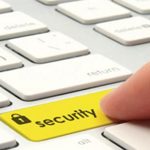DevSecOps: Integrating Security Across SDLC

Security being quintessentially paramount across the software development lifecycle (SDLC), DevSecOps shifts it to the left – the earliest phase of SDLC. It builds a holistic ecosystem of security and performance that improves accuracy and productivity while addressing the requirements at the speed the business requires.
Software development life cycle (SDLC) has taken various forms since its evolution. The field has witnessed the application of diverse philosophies, each of which has brought improvements.
Each evolution brought a new outlook as project managers continued to look for a one-stop approach for managing SDLC. This was until the developments culminated in DevOps.
Today, DevOps is a driving force in most software development projects. Amalgamating several practices and approaches, it stitches together project management, development, and IT operations, tremendously increasing software development velocity.
Integrating development tools and processes tightly, DevOps allows businesses to adjust to changing requirements, fix bugs, and incorporate new features easily and quickly. However, as security is not explicitly integrated into DevOps, security teams must work separately from the development team. In short, security falls outside development and operations and is addressed manually, distorting the DevOps cycle’s automated flow.
DevSecOps overcomes this limitation of keeping security as a separate component of SDLC. It fills the gap by integrating security with development and operations, optimizing the effort and cost of remediation. As we go ahead, we go into the details to understand more about DevSecOps and why the DevOps to DevSecOps transition is essential for managing the software development life cycle of the future.
What are the Security Risks in Software Development?
Security is paramount to any software development project, and each project is vulnerable to potential risks. Enterprise Strategy Group’s (ESG’s) research showed that 66% of enterprises found their application security tools protecting less than 75% of their codebase. Security issues, thus, persist in software development.
Let’s take a quick look at some common security risks in software development:
- Improper governance and management of commercial and open-source components
- Segregating security from other elements of software development.
- Unrestricted access to CI/CD pipelines and code repositories
- Mechanisms are not strong enough to manage sensitive data
- Complete reliance on in-house security expertise
With DevSecOps, project managers and owners won’t have to apply separate efforts to resolve these issues.
By the Way, What is DevSecOps?
DevSecOps embeds security in development and operations and thus works as an extension of DevOps. This driving and managing SDLC model encourages security-as-code ethics, imparting seamless flexibility to every stakeholder in the software development process.
DevSecOps ensures that security works in tandem with Agile and DevOps processes and shortens the time in releasing code and products compared to the traditional DevOps approach. It aims to break down barriers between the development, operations, and security teams, much like DevOps did for the conventional barriers between development and operations.
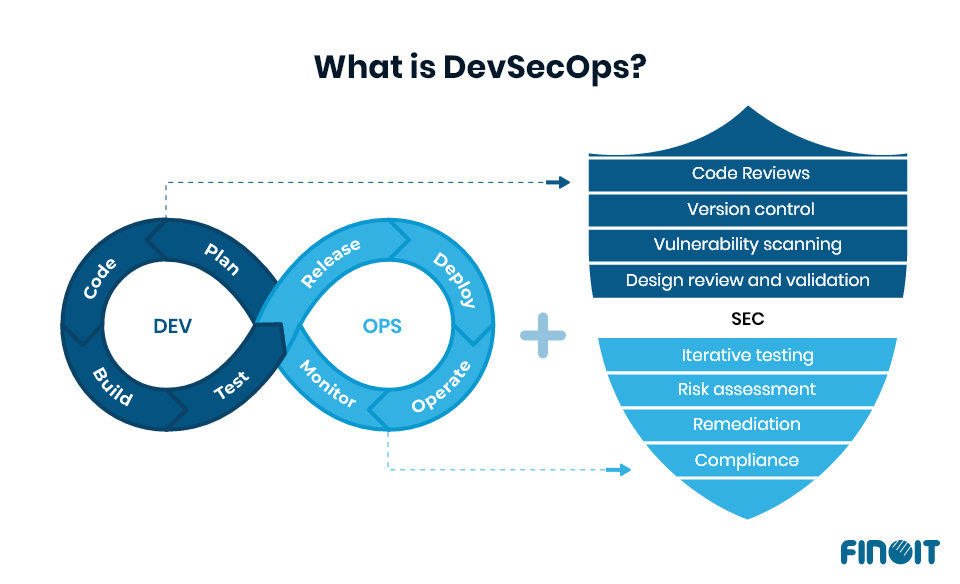
What Does DevSecOps Bring to the Table?
The first place, DevSecOps clarifies that “security is a responsibility of everyone” while ensuring that the speed of development operations is maintained.
The DevSecOps philosophy encourages a cooperative system that provides access to tools and procedures which aid in security decision-making, together with dedicated security experts. It adds value to the system by allowing it to monitor, identify, and address security issues continuously. So, in a nutshell, security is not a part of the process; rather, it’s a process that supervises every step in development operations.
DevSecOps thus constitutes a strong wall that deters attackers. In this process, the need to have additional security professionals to reinforce the DevOps teams is eliminated. Everyone in the business ecosystem, including security staff, can contribute to iterative value generation. Adopting DevSecOps will allow enterprises to improve the application’s stability and shorten the development cycle time.
In traditional SDLC, security would be seen as a barrier to innovation and quick application development. With DevSecOps, the equation is altered, and the test code is subjected to all security validations and inspections. Project teams are thus freed from the worry of addressing security instances like random attacks, breaches, and downtime.
In the process of making security integrated everywhere, DevSecOps brings some key advantages for its adopters, which are:
- Improved Testing Procedures:
DevSecOps incorporates a set of testing procedures, such as integration testing and unit testing, to prevent regressions and enhance the quality of each release. This saves significant time by identifying vulnerabilities early in the development process.
- Cost Reduction:
By identifying vulnerabilities at each stage, DevSecOps reduces the cost of addressing security issues later in the development cycle. It promotes a proactive approach to security, avoiding expensive fixes and potential damage to the application’s reputation.
- Security by Design
DevSecOps follows the “security by design” principle, empowering developers with automated testing mechanisms. By integrating security practices into the development process, applications are built with security in mind from the outset, reducing the likelihood of vulnerabilities.
- Efficient Source Control Management
DevSecOps employs appropriate branching and tagging approaches for source control management (SCM). It ensures that every build is successful and provides complete visibility to stakeholders through automatically generated release notes.
- Collaboration and Continuous Improvement:
DevSecOps encourages collaboration between different teams, fostering a culture of shared responsibility toward security. It allows team members to analyze key performance indicators (KPIs) and continuously improve the DevSecOps process, enhancing efficiency and effectiveness.
- Rapid Deployment:
With blue-green deployment strategies, DevSecOps enables rapid changes and rollbacks, ensuring seamless updates without disrupting the application’s availability. This agility in deployment facilitates faster delivery of new features and fixes.
- Language-Agnostic Approach:
DevSecOps enables teams to use the same processes and tools for applications, regardless of the programming language they are written in. This flexibility promotes consistency and ease of management across diverse technology stacks.
- Reputation Protection:
DevSecOps helps prevent breaches that could damage an organization’s reputation by proactively addressing security vulnerabilities through enhanced auditing and monitoring. It ensures that security is ingrained in the application’s development and operations, safeguarding sensitive data and maintaining customer trust.
DevSecOps Vs. DevOps – Where’s the Edge With DevSecOps?
As per Chris Wysopal, Veracode’s founder and chief technology officer, most business enterprises are attempting to automate security scans. However, he finds that “security debt” keeps the enterprises from immediately achieving the results. This debt results from vulnerabilities that continue to mount into production as developers don’t fix them.
Veracode’s 2019 State of Software Security report analyzed scans on 85000 applications only to find that it would require an astonishing period of 171 days to fix vulnerabilities. The security debt keeps on accumulating, ultimately resulting in financial dept. This is what can happen when you don’t integrate security in DevOps.
Though DevOps has been a sought-after approach to achieving scale and speed and driving innovation, managing security is challenging. The constant fear of data loss, system and business disruption, and IP theft haunts project managers. DevSecOps arrives here, taking DevSecOps a step ahead and applying security functions to monitor risks and vulnerabilities throughout the SDLC to safeguard the collaborative process.
Here is how DevSecOps takes DevOps to the next level.
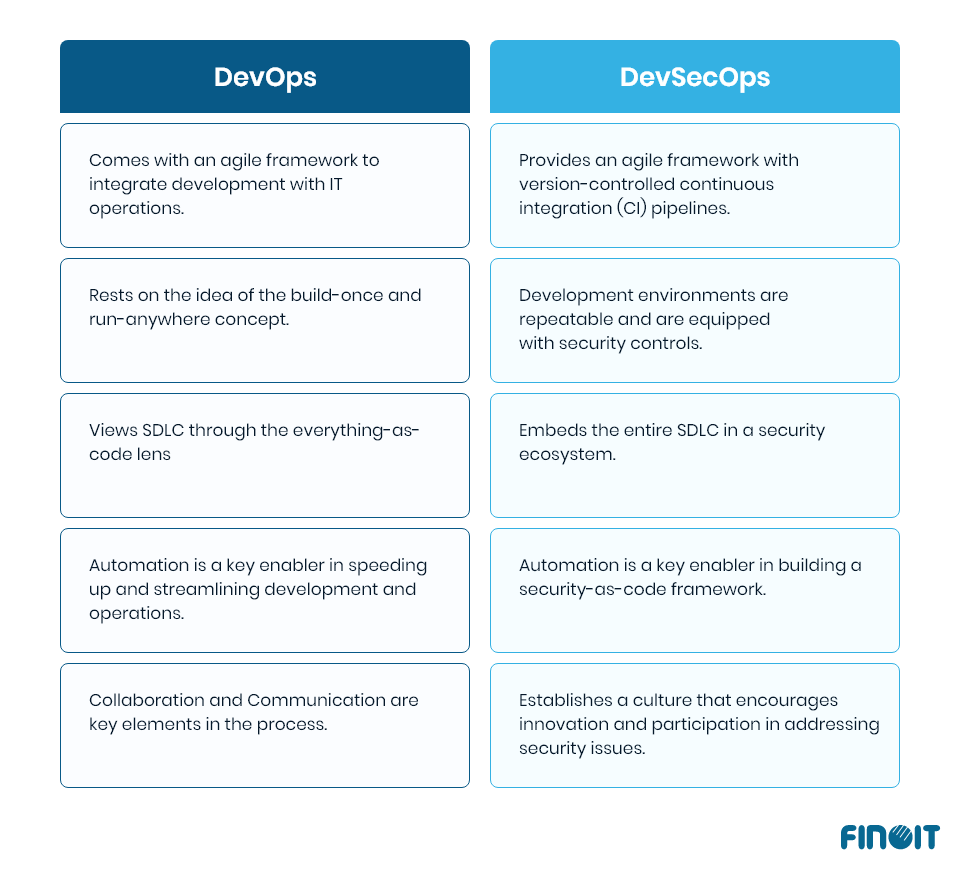
An Ordinary SDLC Workflow
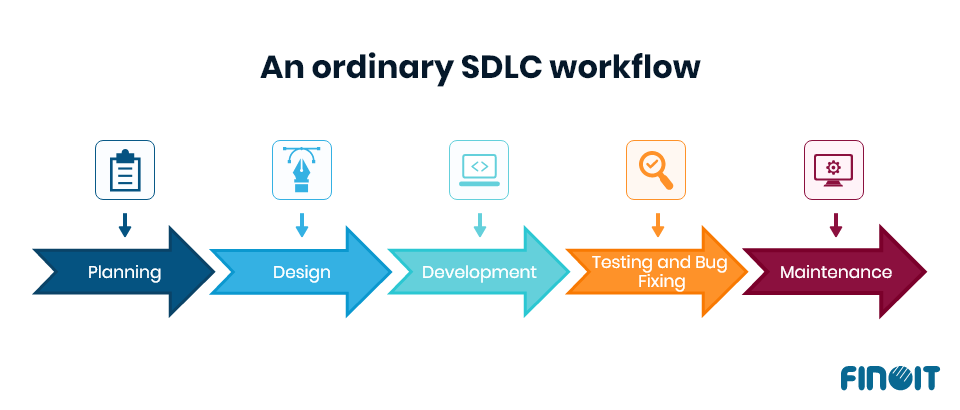
DevOps

DevSecOps
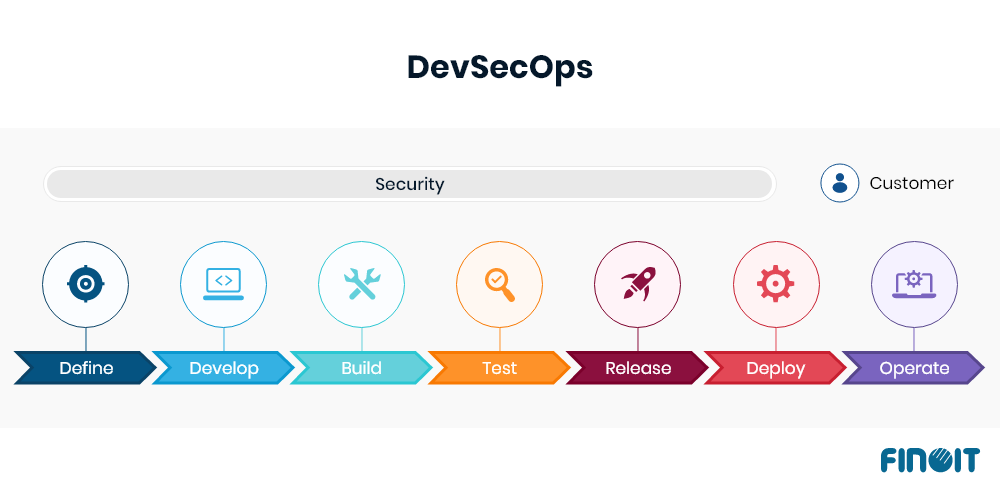
Yes, DevSecOps is Advantageous – But Not Without These Best Practices
The thought of applying DevSecOps might have started enticing you. However, implementing the philosophy requires combining multiple approaches and moving away from the traditional outlook. Summarized here are some best practices for implementing DevSecOps.
- Things start from the beginning
Start by focusing on security right from the beginning of the SDLC. As mentioned, your SDLC must function within a security ecosystem. Unlike DevOps, where security was only considered at the testing stage, DevSecOps brings security into the picture in the earliest phases.
- Embrace the essential principle
Security-as-a-code is vital to the core of DevSecOps. This idea rests on implementing security policies and driving vulnerability scanning to impart a robust character to the SDLC. So, you build a consistent and scalable security framework.
- Know what matters
To derive the benefits of DevSecOps, you must know the right tools and possess the familiarity to integrate them with DevOps. Interactive application security testing (IAST), static application security testing (SAST), and dynamic application security testing (DAST) aid in the early identification of vulnerabilities throughout the SDLC.
- Identify every opportunity
The first step to building a fully secured pipeline is to bring in automation at every key junction. Manual processes are slow and prone to errors, so automation is a prerequisite to establishing DevSecOps.
- Say no to silos
DevSecOps is finally an extension of DevOps, so streamlined communication and coordination are what it demands. Ensure you involve all stakeholders in decision-making, prioritizing security and ensuring team members know their roles.
- Each one counts equally
DevSecOps calls for a shared responsibility to manage and handle security aspects. Right from the development, quality assurance, and project management to C-suite executives, each stakeholder must participate actively in the project.
- Don’t be static
DevSecOps teams comprise members from diverse practices, though each member is involved in the security side of the project. Educating team members from time to time is key to ensuring that team members give justice to their security responsibilities.
- Responsiveness is the key
Incident management with a proactive mindset helps keep security risks at bay. As a result, ensure you are ready with action plans and workflows to resolve incidents. With a continuous responsive mechanism, you can minimize major security incidents effectively.
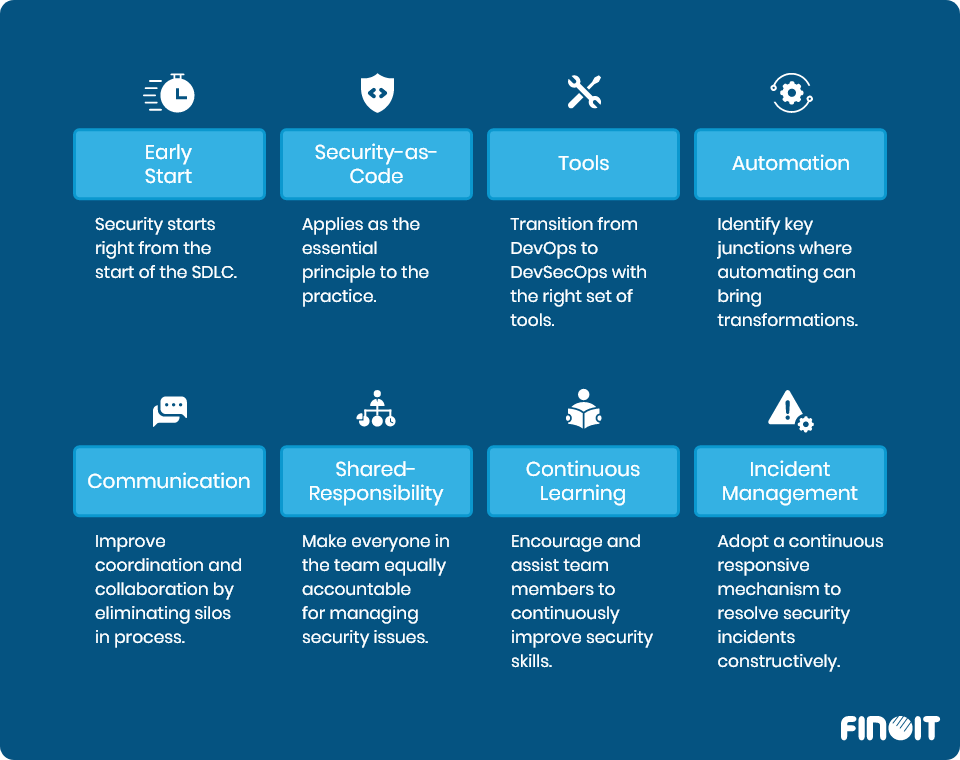
Tools to Implement DevSecOps
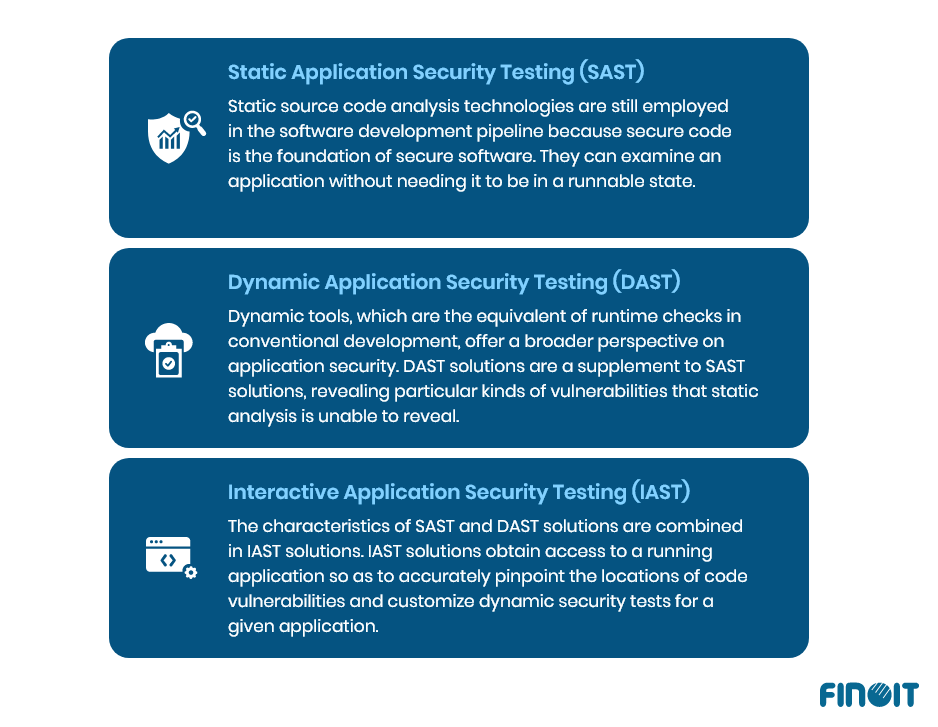
Trends shaping DevSecOps
DevSecOps, integrating security into the software development process, continues to evolve as new trends and advancements shape its future. Let’s explore some emerging trends in DevSecOps and discuss how they are driving its evolution:
Shift-Left Security
One of the emerging trends in DevSecOps is the concept of “shift-left” security. Traditionally, security considerations were addressed later in the software development lifecycle (SDLC), often during the testing phase. However, the shift-left approach emphasizes integrating security practices from the very beginning of the development process. By incorporating security early on, developers can identify and address vulnerabilities and security risks sooner, resulting in more secure and resilient applications.
Infrastructure as Code (IaC)
It is gaining traction in DevSecOps as a way to define and manage infrastructure elements, such as servers, networks, and databases, using code. By treating infrastructure as code, organizations can apply security configurations consistently across their environments, ensuring compliance and reducing the risk of misconfigurations. IaC enables security measures to be implemented and tested as part of the development process, promoting a secure-by-design approach.
Container Security
Containers have become popular for deploying applications due to their lightweight and portable nature. However, securing containerized environments poses unique challenges. As a result, container security has emerged as a significant trend in DevSecOps. Tools and practices such as image scanning, runtime protection, and access control are being implemented to ensure the security of containerized applications throughout their lifecycle.
Security Orchestration, Automation, and Response (SOAR)
SOAR combines security orchestration, automation, and response capabilities to streamline and automate security incident response processes. It enables organizations to automate repetitive security tasks, investigate and respond to incidents more efficiently, and enhance overall incident management. By integrating SOAR into DevSecOps, organizations can improve their incident response capabilities and reduce the time to detect and remediate security issues.
Compliance as Code
Compliance requirements and regulations can be complex and time-consuming to manage. It is an emerging trend involving automation and codification principles to ensure continuous compliance throughout the SDLC. By translating compliance requirements into machine-readable code, organizations can automate compliance checks, perform regular audits, and maintain a state of continuous compliance.
Continuous Security Testing:
Continuous security testing is a crucial aspect of DevSecOps, ensuring that security measures are continuously validated throughout development. This includes activities such as static application security testing (SAST), dynamic application security testing (DAST), and interactive application security testing (IAST). By integrating these testing practices into the CI/CD pipeline, organizations can identify vulnerabilities early and address them promptly, reducing the risk of security breaches.
Security as Code
Security as Code involves applying coding principles to security practices, enabling security policies and controls to be defined and managed as code. This approach allows organizations to automate security configurations, perform security checks using code, and leverage version control systems. By treating security as code, organizations can ensure consistency, repeatability, and scalability of security practices across their software development lifecycle.
DevSecOps – The next frontier for managing your SDLC
Infusing security across every stage of software development lifecycle (SLDC), DevSecOps helps prevent catastrophic security breaches and fosters a culture of transparency. DevSecOps renders a new dimension to an enterprise’s development culture and helps it discover a fresh outlook characterized by secured development operations.
Organizations must thus see in DevSecOps an opportunity to generate real outcomes. To capitalize on its potential, they must make automation, collaboration, and rapid development integral to security management practices.
Security is at the top of the agenda for CIOs today, and with DevSecOps, they can strengthen their position in building a solid security framework for enhanced customer experience. As time runs fast and competition intensifies, CIOs must embrace and implement DevSecOps to achieve agility at scale by making development and operations work under the parasol of security.

